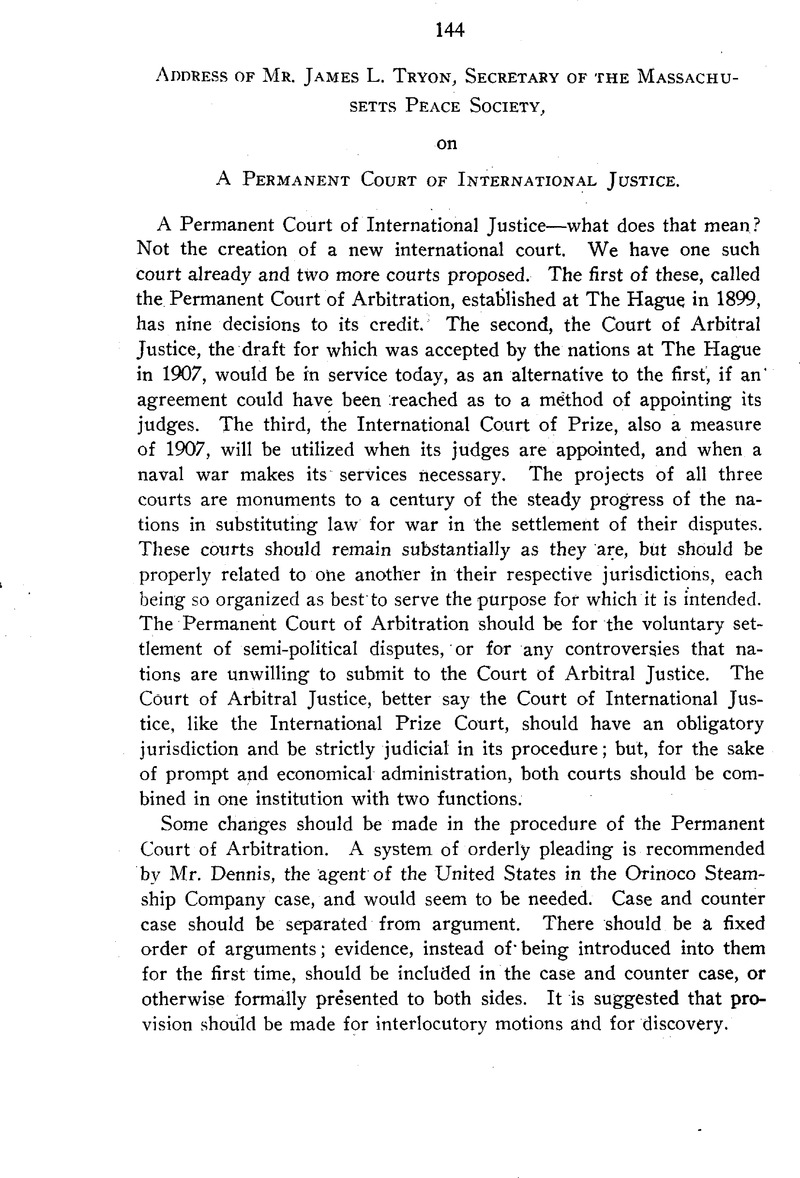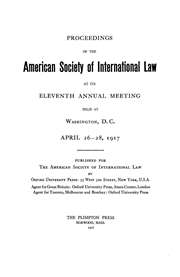No CrossRef data available.
Article contents
Address of Mr. James L. Tryon, Secretary of the Massachusetts Peace Society, on A Permanent Court of International Justice
Published online by Cambridge University Press: 27 February 2017
Abstract

- Type
- Fourth Session
- Information
- Proceedings of the American Society of International Law at its annual meeting (1907-1917) , Volume 6 , 1912 , pp. 144 - 160
- Copyright
- Copyright © American Society of International Law 1912
References
1 It is admitted that the Fisheries case was so strictly legal in its technicalities as to be beyond the comprehension of the ordinary layman, and to be without the possibilities of a sensation for the “yellow journalist” from the standpoint of either British or American national feeling. Reference to the argument of Mr. Root will show the legal nature of that great case. If the judgment had in it elements of compromise, these have been satisfactorily explained by a recent letter from Dr. Lammasch. He insists, with good reason, that in all three cases over which he bas presided, the Muscat, the Orinoco Steamship, and the North Atlantic Fisheries cases, the decisions have been juridical. The trouble with the decision of the Venezuela Preferential Payment case, of which there was the most criticism, was that it was legal instead of ethical, as the distinguished counsel for the United States and Venezuela would have had it; but, although it favored the methods of war, in spirit, by recognizing blockade as a legal means of redress, it, in fact, prevented war, and, by following upon the Drago letter, helped to put controversies over the contractual debts on a peace basis for the future, for that case prepared the way for the Borter-Drago convention, which was adopted at The Hague in 1907.
The Casablanca case, though legal in respect to the points of international law involved in it, must be admitted to have been diplomatic in its final conclusions, which, however, saved the honor of both parties.
2 The idea of a court of nations goes back at least as far as Henry IV, Emeric Cruce, Grotius, and William Penn, but, as outlined by them and their successors, the early schemes for an international court provided for an assembly of ambassadors acting as judges rather than for a tribunal of jurists. William Ladd, in his Congress of Nations, made a definite departure from the suggestions of all these writers by separating the idea of a court from that of a congress. In his plan, the congress was to codify the law of nations, the court to apply it. In the nineteenth century arbitration made great progress apart from the peace propaganda, as it was tried by many of the governments, particularly the United States and Great Britain, for the pacific settlement of their disputes. This method of adjudicating international controversies, however, was open to the criticism that arbitral tribunals came to their decision by compromise, the judges taking the place of negotiators and settling the questions before them by diplomatic adjustment. This method of arriving at a decision led to the fear of partiality, and prevented the submission of international questions, which might otherwise have been adjudicated had there been an international court of jurists acting upon known principles of law, and deciding their cases according to the records before them. This was pointed out in a memorable address, entitled “The American Sentiment of Humanity,” by Hon. Elihu Root, at the New York Peace Congress of 1907; see report p. 34. Mr. Root, who was’ then Secretary of State, embodied the leading thought of his address in his Instructions to the American Delegates to the Second Hague Conference, with the result that they proposed the Court of Arbitral Justice, a judicial court based upon Mr. Root’s idea. This court, adopted in principle by the nations, marks a steady advance in the conception of an international court from a diplomatic to a judicial body, Mr. Root having eliminated from the prevailing conception the idea of compromise. It will be seen, upon examination of the plans both of Mr. Ladd and Mr. Root, that they were influenced by the success of the United States Supreme Court, which is purely judicial in its character.
Among American publicists, the most voluminous and suggestive writer on the Court of Arbitral Justice is Dr. James Brown Scott, who, as the Technical Delegate of the United States to the Second Hague Conference, elaborated and championed the scheme of the court. For his writings and addresses, see 2 American Journal of International Law, 772; the Reports of the Mohonk Arbitration Conferences since 1907; the Pennsylvania Peace Congress Report, 1908, p. 98; the Chicago Peace Congress Report, 1909, p. 234 (Some Subjects Likely to be Discussed at the Third Hague Conference) ; the New England Peace Congress Report, 1910, p. 83, “Oration on Elihu Burritt,” and Dr. Scott’s volume of American Addresses at the Second Hague Conference, published by Ginn & Company, 1910. See also his article on the International Court of Prize in 5 American Journal of International Law, 302, which is closely connected in organization and historical development with the Court of Arbftr’al Justice; and “The Evolution of a Permanent International Judiciary” in the April, 1912, number of the American Journal of International Law.
For the Hague conventions and other action relating to the three courts, already established or projected at The Hague, see 2 James Brown Scott’s The Hague Peace Conferences of 1899 and 1907, and A. Pearce Higgins’ The Hague Peace Conferences. Introductory and explanatory matter will be found in 1 Scott’s Hague Peace Conferences, and in Higgins’ invaluable work. See also William I. Hull, The Two Hague Peace Conferences, and Thomas J. Lawrence’s Principles of International Law. Articles on these courts by the present writer are as follows: The Proposed High Court of Nations, Yale Law Journal, January, 1910; The International Prize Court and Code, ibid, June, 1911; and The Hague Peace System in Operation, ibid, November, 1911. The latter article takes up the cases decided by the Permanent Court of Arbitration. The championed the scheme of the court. For his writings and addresses, see 2 American Journal of International Law, 772; the Reports of the Mohonk Arbitration Conferences since 1907; the Pennsylvania Peace Congress Report, 1908, p. 98; the Chicago Peace Congress Report, 1909, p. 234 (Some Subjects Likely to be Discussed at the Third Hague Conference) ; the New England Peace Congress Report, 1910, p. 83, “Oration on Elihu Burritt,” and Dr. Scott’s volume of American Addresses at the Second Hague Conference, published by Ginn & Company, 1910. See also his article on the International Court of Prize in 5 American Journal of International Law, 302, which is closely connected in organization and historical development with the Court of Arbftr’al Justice; and “The Evolution of a Permanent International Judiciary” in the April, 1912, number of the American Journal of International Law.
For the Hague conventions and other action relating to the three courts, already established or projected at The Hague, see 2 James Brown Scott’s The Hague Peace Conferences of 1899 and 1907, and A. Pearce Higgins’ The Hague Peace Conferences. Introductory and explanatory matter will be found in 1 Scott’s Hague Peace Conferences, and in Higgins’ invaluable work. See also William I. Hull, The Two Hague Peace Conferences, and Thomas J. Lawrence’s Principles of International Law. Articles on these courts by the present writer are as follows: The Proposed High Court of Nations, Yale Law Journal, January, 1910; The International Prize Court and Code, ibid, June, 1911; and The Hague Peace System in Operation, ibid, November, 1911. The latter article takes up the cases decided by the Permanent Court of Arbitration. The student of the subject will profit by reading discussions of-these courts in the Proceedings of the American Society of International Law for 1908 and 1909. He will also find related topics in the development of international justice, treated in the Procedings of 1910 and 1911; and the latter for a code of international law especially. Valuable and inspiring sources of information and suggestion will be found in the reports of the American Society for Judicial .Settlement of International Disputes for 1910 and 1911, in which are papers on the problem of a Court of International Justice, with helpful analogies to the Supreme Court of the United States. See especially the artiples or addresses in the report for 1910, by Hon. Elihu Root, Hon. Henry B. Brown, Frederic D. McKenney, Alpheus H. Snow, Professor Eugene Wambaugh, Hon. Jackson H. Ralston, Hon. Andrew J. Montague, Hon. Simeon E. Baldwin, President Charles W. Eliot, and Hon. William Dudley Foulke. Mr. Theodore Marburg wrote a valuable summary of the thought of that conference, which should be consulted in order to get a consensus of American opinion. The pamphlets by this society reproduce some of the addresses already referred to, but “An International Court of Justice the Next Step,” by George Grafton Wilson, is newly printed. This is useful as marking the state of temporary thought on the subject.
Other articles referred to in the text are as follows: Compromise, the Great Defect of Arbitration, by Hon. William Cullen Dennis, 11 Columbia Law Review, p. 509 (Mr. Dennis thinks that, for the present, a code of procedure in international arbitration is an even more imperative need than a code of substantive law); William Cullen Dennis, S American Journal of International Law, pp. 59–63; Thomas Raeburn White, The Underlying Principles Which Should Govern the Method of Appointing Judges of the International Court of Arbitral Justice, Mohonk Arbitration. Report, 1911, p. 102; Alpheus Henry Snow, Legal Limitation of Arbitral Tribunals, 60 University of Pennsylvania Law Review, December, 1911. This article should be carefully compared with Mr. Snow’s article on the Development of the American Doctrine of the Jurisdiction of Courts over States, 1 Judicial Settlement of International Disputes, 100.
For discussions of the problems of an international court of justice by delegates of the Hague Conferences, the best original sources are the proceedings which are in French. Brief resumes of these discussions in English will be found in 1 Scott’s Hague Peace Conferences, Higgins’ Hague Peace. Conferences; and Frederick W. Holls’ The Peace Conference at The Hague.
For an official discussion of the problem of the relation of the Court of Arbitral Justice to the International Prize Court, see identic circular note by Hon. Philander C. Knox, Secretary of State, in 4 American Journal of International Law, p. 102. The combination of these courts in. one, which is suggested by the present writer, is also proposed by Secretary Knox, with this difference, however, that the foundation of the plan of the Secretary of State is the International Prize Court, as that institution is already in a more advanced state of acceptance than the Court of Arbitral Justice, while the present writer’s -scheme makes the Court of Arbitral Justice the foundation. The plans further differ in that the first utilizes the scheme of judges already accepted for cases of prize, which permits nations to have individual representatives on the tribunal, while the second proposes that the judiciary be chosen from the nations at large, none of them to have the right to claim representation by an individual judge.




